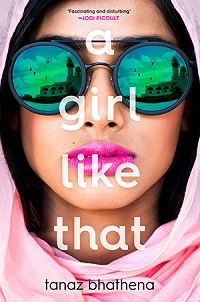| ________________
CM . . . . Volume XXIV Number 14. . . . December 8, 2017
excerpt:
Zarin Wadia is a 16 year old who doesn’t fit the social mold of the girls around her at school, and, therefore, she is not liked by most of her peers. She is a risk-taker who is more than willing to say what is on her mind and, apparently, thereby seeks attention. Family and friends all label her a troublemaker, “a girl like that”, someone to be wary of. When she and friend Porus are killed in a car accident, those who knew her are forced to think more about Zarin, and they realize that, perhaps, the real girl was quite different from the one they imagined. This is a superb first novel from Tanaz Bhathena, and she has given her readers a main character who is not always likeable but is believable. Zarin is a young woman who will be difficult to forget. Within the novel, she learns about herself and begins to understand what it is to be truly loved by someone. She is strong and opinionated and often rebellious, but readers get a glimpse under her tough façade and understand that she is also a human who can be easily hurt and humiliated. The main male character in the novel is Porus, a young man who seems an unlikely hero. He loves Zarin with a steadfast loyalty which will endear him to readers. He stands up for what he believes in and will take risks for love. He is unlike the more brash young men who will go to any means to lure a pretty girl and then enjoy bragging rights later on in the locker room. Porus is genuine, thoughtful and steadfast and an excellent foil for Zarin’s tempestuous nature. The setting of the novel is Jeddah, a port on the Red Sea in Saudi Arabia and a city familiar to the author as she was born in Mumbai and raised in Riyadh, Jeddah and Toronto. The city is almost another character in the story thanks to Bhathena’s vivid descriptions. The many details about the urban environment and the use of Arabic, Hindi and Gujarati vocabulary introduce the Canadian reader to a city and country quite different from our own, and Bhathena provides insights into both religion and culture. The story begins with a chapter from Zarin’s point of view followed by one from the point of view of Porus. Readers quite quickly understand that they are spirits speaking directly following the car accident which killed both teens. Throughout the story then, readers know that the main characters will be killed and yet that doesn’t keep them from being interested in the plot and emotionally involved in the various relationships of the book. As the story progresses, chapters are told from the points of view of several characters in the novel, and this approach gives readers a better opportunity to build up a complete picture of the events and the personalities involved. Bhathena touches on so many themes that it is difficult to tease out only one or two which are most important. Perhaps the word oppression covers many of the various motifs of the novel. There are elements of both race and religion which oppress those involved, both male and female, and certainly Zarin deals with a sense of alienation from those around her at times. More specific themes include bullying at school as well as on social media. Abuse and rape culture also form an important theme of the novel. Bhathena is not afraid to have characters who confront and deal with all kinds of issues. On the happier side, romance and finding love are also a focus of the book, and readers see many characters who love – for both the right and the wrong reasons. A Girl Like That is a novel which raises many questions and which will spark comment and debate among its readers. The characters and setting are fascinating and exotic. Much of the action is thought provoking and disturbing. A Girl Like That is a book which readers will enjoy and will remember long after other novels come and go. Thank you, Tanaz Bhathena, for such a wonderful and memorable story! Highly Recommended. Ann Ketcheson, a retired teacher librarian and high school teacher of English and French, lives in Ottawa, ON.
Next Review |
Table of Contents for This Issue
- December 8, 2017. |
